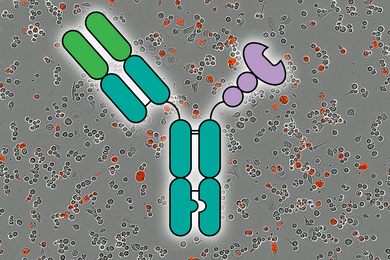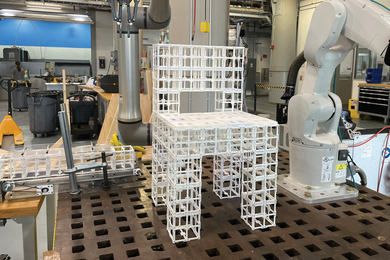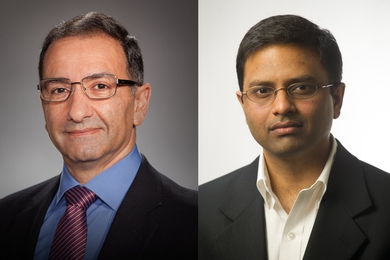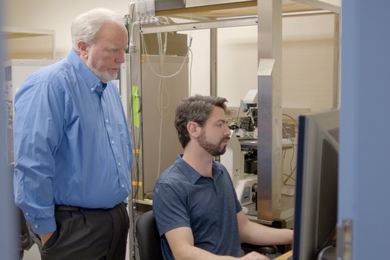Study aims to make aircraft greener
Life-cycle assessment of a product, or viewing that product holistically from production through final disposal, has been primarily associated with consumer goods. But the notion is also applicable to other, more complex products.
The MIT Technology, Business and Environment Program (TBEP) is conducting a study of the environmental consequences of building, operating, and disposing of military aircraft. One of the first tasks in this study has been to identify the environmental life cycle and the important actors and organizations that influence that cycle, from early concept development to the continuing support and operations phases that may last for many decades after a plane is introduced. The study is being coordinated with the MIT Lean Aircraft Initiative, which aims to increase the productivity of aircraft manufacture. Led by Dr. John Ehrenfeld of TBEP, the study is funded by the EPA and the US Air Force. (Source: Technology, Business and Environment Program)
New material from corn
Plastic is commercially popular because it is flexible, waterproof and inexpensive, but it is not biodegradable.
Dr. Edwin Thomas, professor of materials science and engineering, has developed a more environment-friendly material combining corn starch and poly(ethylene vinyl alcohol) or EVOH. However, this material can become soft or brittle with changing atmospheric conditions. Consequently, Dr. Thomas has focused on creating a one-micron-thick surface coating with the protective properties of pure plastic. He does this by varying the ratio of the ethylene and vinyl alcohol monomers in the EVOH to get properties that range from nonbiodegradable polyethylene to water-soluble, biodegradable polyvinyl alcohol. Because the EVOH has a lower molecular weight, surface tension and viscosity than the starch component, it naturally ends up at the surface because it is more attracted to the air interface. Once the product is discarded and shredded, the more starch-heavy (and thus biodegradable) interior will be exposed to the elements.
Professors Robert Armstrong and Edward Merrill have helped with the research, which is funded by the US Department of Agriculture, Warner Lambert, the National Association of Wheat Growers and NSF.
Assessing ship damage
Oil tankers and other ships can be designed to survive grounding accidents with minimum catastrophic damage to their hulls and the surrounding environment.
Dr. Tomasz Wierzbicki, a professor in the Department of Ocean Engineering, heads a group that has developed a PC-based software program and a Handbook on Grounding Protection of Ships that can provide quick and accurate estimates of hull-bottom structural damage.
The program called DAMAGE (DAMage Assessment in Grounding Events) employs theoretical models to gauge energy dissipation, fracture and tearing processes, contact and friction phenomena, and the forces necessary to drive rocks and wedges of various geometries into stiffened metal plates. The results are being used to predict longitudinal and vertical damage of various types of oil tankers and other ships (including single- and double-hulled) involved in grounding and stranding accidents.
Experiments involving small-scale hull models were performed to validate the predictions. The work, which is being extended to include estimates of damage to other parts of a ship, is funded by the Joint MIT-Industry Project on Tanker Safety, a multi-national consortium of private firms, regulatory agencies and government including the US and Canadian Coast Guards. A new project, Rupture of Oil Tankers in a Side Collision, is funded in part by the Oil Pollution Research Grant program of the US Department of Transportation.
Sources of uncertainty in climate change predictions
Most experts agree that emissions from human activities are increasing atmospheric concentrations of carbon dioxide and other "greenhouse gases" that may warm our atmosphere.
But experts do not agree on how those higher concentrations will affect our climate, so policy-makers considering emissions regulations do not know whether to take immediate action or wait for better information.
To assist the policy-making process, Professors Henry Jacoby of the Sloan School of Management and Ronald Prinn of the Department of Earth, Atmospheric and Planetary Sciences examined the many sources of uncertainty that now make policy choice and timing unclear. Among the phenomena they analyzed were "feedback" effects that captured heat could have on atmospheric, biospheric and oceanic processes.
The researchers emphasize that overall uncertainty would be reduced most by better understanding three processes: convection, cloud formation and ocean circulation. However, they also conclude that progress in these areas will be slow during the next decade. So uncertainty about climate change-and about appropriate policy action-will likely persist. The research was supported by 14 industrial and governmental sponsors through the MIT Joint Program on the Science and Policy of Global Change, of which Professors Jacoby and Prinn are co-directors. Nancy Stauffer, Energy Laboratory
A version of this article appeared in MIT Tech Talk on October 25, 1995.





